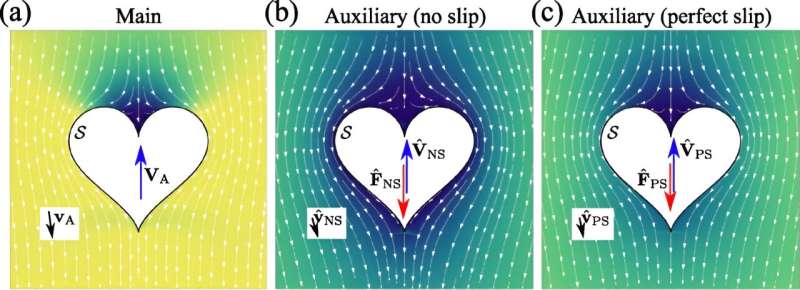This article has been reviewed according to Science X's editorial process and policies. Editors have highlighted the following attributes while ensuring the content's credibility:
fact-checked
peer-reviewed publication
trusted source
proofread
New insights into broken symmetries: Applying the Lorentz reciprocal theorem to fluids with odd viscosities

The Lorentz reciprocal theorem can now be applied to fluids with broken symmetries. Scientists at the Max Planck Institute for Dynamics and Self-Organization (MPI-DS) in Göttingen have found a way to also accommodate this classical theorem in fluids with odd viscosities. Their discovery opens a new way to explore systems with broken symmetries.
Symmetries are fundamental to physics. Generally, a physical process is considered symmetric if it appears identical when viewed as a mirror image or when time is reversed. In hydrodynamics, a consequence is that the flow around a moving object is the same as if the direction of motion is reversed. The invariance of the flow streamlines causes the force on the object to remain unchanged under motion reversal. This is described by the Lorentz reciprocal theorem, which enables researchers to solve even complex fluid dynamics problems.
However, some systems show broken symmetries resulting in a so-called odd viscosity of the fluid. Here, the Lorentz theorem could not be applied. The scientists Yuto Hosaka, Ramin Golestanian, and Andrej Vilfan from Department of Living Matter Physics at the MPI-DS have now gained new insights into such systems with broken symmetries. Their paper is published in the journal Physical Review Letters.
"We found a way to extend the theorem to odd viscosity without violation," reports Yuto Hosaka, first author of the study. "Our generalization allows for a wide range of analytical calculations for fluids, including self-propelled microorganisms in living systems."
The researchers used their new insights to analyze the behavior of different microswimmers. Thanks to their generalization, the Lorentz theorem can link the behavior of moving microswimmers to non-motile objects of the same geometry in odd viscosities.
Yet, this application is not limited to the hydrodynamics of microswimmers. "Since related reciprocal theorems exist in a wide range of physical fields, our work gives researchers a new tool to explore the systems with broken symmetries," concludes Hosaka.
More information: Yuto Hosaka et al, Lorentz Reciprocal Theorem in Fluids with Odd Viscosity, Physical Review Letters (2023). DOI: 10.1103/PhysRevLett.131.178303
Journal information: Physical Review Letters
Provided by Max Planck Society





















